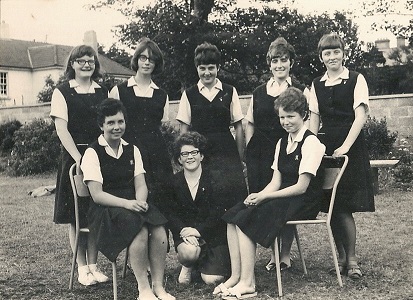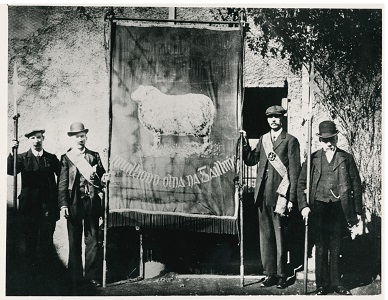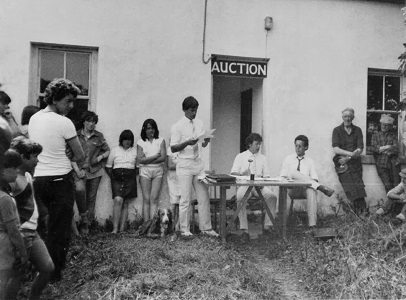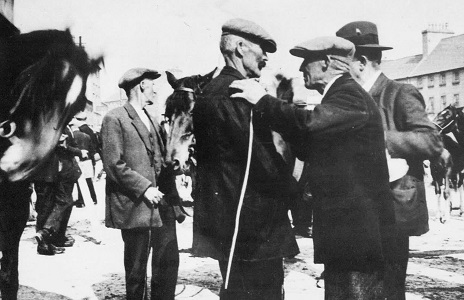Old Galway
AN HISTORIC AIR MAIL FLIGHT FROM GALWAY TO BERLIN

by Tom Kenny
Ninety years ago, on October 22nd, 1932, a Fox Moth plane piloted by Captain Armstrong took off from Oranmore carrying mails and two passengers, Peggy Kenny and Kitty Curran, thus starting the first Irish–Continental European air mail delivery and the first passenger service. The mails were handed to the pilot by the postmaster Mr. C. Lynch. Bad weather at Athlone meant they had to fly blind a few hundred feet above ground for some time. This ‘feeder’ part of the overall journey was sponsored by Galway Harbour Board to the tune of £80. The flight took 55 minutes, it took the ladies four hours to get home on the train.
At Baldonnel, 14 passengers boarded the 30-seater monoplane (described as a ‘giant plane’) which was piloted by Col. Charles Russell, and 45 minutes after the arrival of the plane from Galway, they took off. They had taken on some extra mail to add to the mails from Galway. They landed in Croydon at 11.55am to refuel. Their next stop was Rotterdam which they reached at 1.05pm, had a quick bite to eat and took off for Berlin at 1.45pm. As they passed Brandenburg, their attention was drawn to lights that flashed every thirty miles guiding aircraft to Berlin. “The aerodrome – the best and most up to date in the world – lights two or three acres with red lights among the grass to guide us down, a runway of white lights standing out for the final landing.”
SALERNO, 60 YEARS OF SECONDARY EDUCATION

by Tom Kenny
In the late forties and early fifties, the population of Salthill began to grow dramatically with the building of lots of individual houses and estates such as Devon Park and Ardnamara. There was a national school at Nile Lodge but it was full to capacity, so the bishop invited the Sisters of Jesus and Mary to open another one.
They took over a small hotel known as Dalysfort House and converted it into a school called Scoil Íde which opened on May 1st, 1952. They began with 43 pupils, but this number increased very rapidly making the building too small, so they demolished it and built a new school to cater for 450 students. This opened on July 2nd, 1962 and that year they opened a ‘secondary top’, a secondary school class housed in their building. Two years later, this little secondary school had three classes.
THE GALWAY WOOLEN MILLS

by Tom Kenny
In 1895, the Galway Woolen Mills opened in Newtownsmith on land that was owned by Marcella Burke. The project was set up to provide employment, especially for young women, rather than to generate profits. Fr. Dooley, the diocesan administrator, was the driving force behind the project and it was known locally as “Fr. Dooley’s Mill’ long after he died in 1911. He took over three houses in order to build the mill. The hours were long and the pay was not great, 7/6 for women and 18 shillings for men.
It became a successful business. Just before WW1, the wage bill was £5,000, after the war it was £15,000 and in 1919, profits to the amount of £5,772 were distributed among the staff.
THE CORRIB HOSIERY FACTORY

by Tom Kenny
This factory was situated in Newtownsmyth in a tall building that later became part of the ESB complex. It was quite a big employer of the day in the city, employing mostly young girls and women.
It was described thus by Jane Hackett (née Gallagher) as follows, “I really didn’t have to apply for the job. There was this woman, a manageress, Nellie Kavanagh – She was Mrs. Hehir afterwards – who lived over in Woodquay in McDonagh’s Terrace, and my mother asked her was there any vacancies in the Hosiery, and she said ‘Send her over on Monday morning’. She said she’d see the manager and that’s how I got the job. It was very well looked after, a clean place to work, very spacious. You weren’t confined. There were different sections. On the ground floor there were the looms and upstairs you’d have the winding.
GALWAY AUCTIONEERS

by Tom Kenny
An auctioneer is described as an agent who accepts bids and sells goods at auction. The profession goes back thousands of years. In ancient Babylon for instance, they used to hold auctions of women for marriage, indeed it was considered illegal to allow a daughter to be sold outside the auction process. In ancient Rome, they regularly held slave auctions. The idea of auctions as we know them today began in England in the late 17th century. They were referred to as English Auctions where bids came in an ascending order.
In 1825, there were three auctioneers listed in Galway, James Clinch, High St; Andrew McHugh, Lombard St. and Michael Martin, Shop St. Some thirty years later, that number had grown to five, Thomas Connell, Churchyard St: Michael Mannion, Abbeygate St: Jim Nevin, Middle St: Thomas O’Connell, High St, and Edward Staunton, Lombard St.
MERLIN PARK HOSPITAL

by Tom Kenny
Tuberculosis is an infectious and very debilitating disease that affects the lungs. It was previously known as consumption because of weight loss suffered.
The planning for regional sanatoria to fight this disease in this country began in 1945 before Streptomycin and other anti-tuberculosis drugs were anticipated. A Government Act of that year enabled the Department of Health to compulsorily buy land and property suitable for such hospitals. The original site chosen in Galway was the property of Col. Joyce in Mervue. He and his wife came to an arrangement with the department for the sale of his 8 acres and plans were being drawn up for the siting of 40 bedded units. However, the Redemptorists, whose house of studies was next door, objected, and so the search for another property began.
HORSE TRADING IN EYRE SQUARE

by Tom Kenny
One of the earliest associations of Eyre Square with the horse was the jousting competitions that went on there in the middle ages. There were also horse fairs held in the Square where one could buy and sell horses, these were usually held outside the railings and on the streets. Before motorised machine were invented, the horse provided people with their main type of transport: the work horse was an invaluable part of the farm used to pull the plough or haul the farmer and his cartload of produce into town. Horse racing was always a popular sport and the first Galway Horse Show was held in the Square in 1892.
HURLING, GAME OF LEGEND AND OF LEGENDS

by Tom Kenny
Hurling is one of the oldest field games in the world. Some stories portray it as a form of military training, proficiency on the field equated with skill in battle. Legend has it that the first battle of Moytura fought about 2000 B.C. between two rival tribes, was preceded by a fierce hurling match between two teams of 27 a-side drawn from opposing forces. The casualties were buried under a huge stone cairn – a megalithic tomb. The field where the game took place is still called The Field of the Hurlers. Ancient games were also played at Tara.
Lowry Loingseach, the legendary pagan king with the ass’s ears was suddenly cured of deafness when accidentally struck by a hurl in a hurling contest. Setanta was a warrior hero and a demigod whose feats on the hurling field are legendary, he killed the savage hound of Culainn in self-defence and thereafter was known as Cú Chulainn. Fionn Mac Cumhaill and the Fianna played hurling. Some kings left up to 50 hurleys and hurling balls in their wills so that their sons and warriors would carry on the noble game. The earliest written reference to the game was in the 5th century Brehon Laws. Hurling was outlawed in the 12th century by the Normans and later a bishop threatened to excommunicate any Catholic who played the “reprehensible game of hurling since it led to mortal sins, beatings and homicides”.
